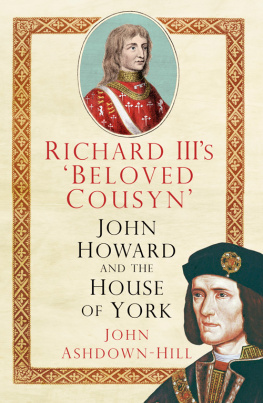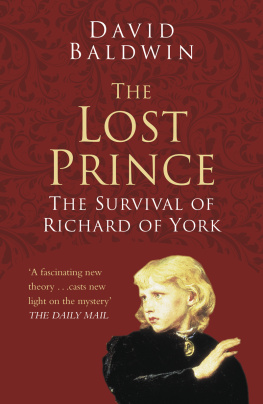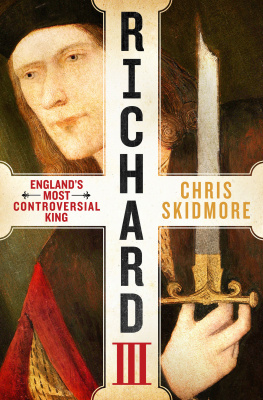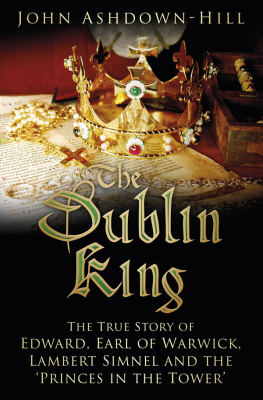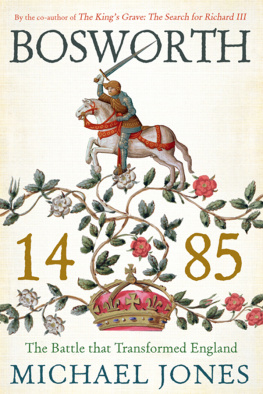
The Last Days of Richard III and the fate of his DNA
THE BOOK THAT INSPIRED THE DIG
The Last Days of Richard III and the fate of his DNA
John AshdownHill

In memory of Joy Ibsen,
Richard IIIs niece in the sixteenth generation,
without whose help the final chapters could not have been written.
| Durmete, rosal, | Sleep, my rose, |
| que el caballo se pone a llorar. | for the horse is starting to weep. |
| Las patas heridas, | Hooves wounded, |
| las crines heladas, | mane frozen, |
| dentro de los ojos | a silver dagger |
| un pual de plata. | in his eyes. |
| Bajaban al ro. | Down they went to the river. |
| Ay, cmo bajaban! | Oh, how they went down! |
| La sangre corra | The blood was flowing |
| ms fuerte que el agua. | faster than the water. |
Federico Garca Lorca, Bodas de Sangre [Blood Wedding] act 1, scene 2
(translation J. Ashdown-Hill)
the truth is that those of us who were alive then never knew what really happened
J.K. Rowling, Harry Potter and the Deathly Hallows, p. 129
Front: Richard III Paston Portrait Society of Antiquaries of London
First published in 2010
Second edition published in 2013
The History Press
The Mill, Brimscombe Port
Stroud, Gloucestershire, GL5 2QG
www.thehistorypress.co.uk
This ebook edition first published in 2013
All rights reserved
John Ashdown-Hill, 2010, 2011, 2013
The right of John Ashdown-Hill, to be identified as the Author of this work has been asserted in accordance with the Copyrights, Designs and Patents Act 1988.
This ebook is copyright material and must not be copied, reproduced, transferred, distributed, leased, licensed or publicly performed or used in any way except as specifically permitted in writing by the publishers, as allowed under the terms and conditions under which it was purchased or as strictly permitted by applicable copyright law. Any unauthorised distribution or use of this text may be a direct infringement of the authors and publishers rights, and those responsible may be liable in law accordingly.
EPUB ISBN 978 0 7524 9866 9
Original typesetting by The History Press
Contents
List of Illustrations
Illustrations not otherwise attributed are the property of the author.
Illustrations in the Text

Introduction
There have been innumerable books about Richard III, but this one is unique because it combines the true story of the last five months of Richards life with the true story of the fate of the kings body and DNA after his death.
First and foremost, my study focuses upon a detailed exploration of the last 150 days of the life and reign of Englands most controversial king, examining in detail what Richard did from Friday 25 March 1485 (the first day of the medieval English New Year) up to Monday 22 August that same year. It also considers what thoughts may have preoccupied Richard during those last five months of his life.
It is surely a great mistake almost bound to lead to errors to view historical events in the light of hindsight. Yet most accounts of Richard III have been greatly overshadowed by the Battle of Bosworth an event of which Richard himself never heard. The fact of that final battle cannot, of course, be ignored but neither should Richards unawareness of it. Therefore, this book deliberately seeks to see things as they might have appeared to contemporaries, most of whom must simply have assumed, at the beginning of 1485, that Richard III still had many years of life and reign ahead of him.
It then becomes clear that Richard himself also assumed that he would continue to reign victoriously. Despite the gloomy view presented by previous writers, during what we now know to have been the last months of his life the king was not simply winding down and waiting for his cousin, known as Henry Tudor, to come and defeat him. On the contrary, he was preoccupied with ordinary events and activities, with his own day-to-day life, and with the proper government of his country. At the same time he was also busy with important plans for the future real plans at the time even though ultimately destined to come to nothing.
This study also consciously seeks to avoid overshadowing Richards actions with reports of the doings of his rival, the so-called Henry Tudor. Since the latter was ultimately victorious (with the result that he and his supporters were around subsequently to talk to early historians), it is unfortunately the case that most previous books about Richard III actually tell us more about what the future Henry VII was doing between March and August 1485. By contrast, this book concentrates on Richards activities.
In order to establish the context for some of the important happenings and concerns of those last 150 days, the account actually opens about ten days earlier, thus encompassing the sickness and death of Richards consort, Queen Anne Neville. It also glances back even further, to the death of Richards only legitimate son and heir, Edward of Middleham, thereby setting in context the problem of the succession, which was unquestionably one of the principal concerns occupying Richards mind during those last few months of his life.
But this book also differs from every other book on Richard III in another respect. Its story does not simply end on Monday 22 August with Richards death. The second part of this study goes on to cut through five centuries of persistent mythology and recount the true fate of Richards body.
First, we examine the immediate aftermath of the Battle of Bosworth: how Richards dead body was transported back to Leicester, placed on public view, and subsequently buried in the choir of the Franciscan Priory Church. New insights into the handling of the corpse are offered, based upon a careful consideration of the most contemporary accounts available, and informed by the recorded treatment of the remains of other vanquished leaders, both in England and elsewhere in Europe, at about this period. Detailed evidence of Richards burial is drawn from the recent excavations on the Greyfriars site in Leicester an archaeological project which was principally inspired by the first edition of this very book.
We also examine the subsequent commemoration of Richards burial in Leicester. We trace the erection, about ten years after Richards death, of his alabaster tomb exploring when, why and by whom this monument was constructed, and what subsequently became of it. As a result, a new and more subtle interpretation of Henry VIIs attitude to his predecessor emerges. Then we look at the post-Dissolution monument, which was erected in Richards honour, and on his grave site, by a former mayor of Leicester after the Greyfriars church had been destroyed.
Finally, the reader is taken on into totally new territory, exploring the ultimate fate of Richard IIIs mortal remains, and revealing the fascinating story of how his DNA was found by the author, alive and well, and living in Canada. The penultimate chapter recounts the fascinating history of that key all-female line of descent, which permitted DNA evidence to be used to confirm the identity of the body excavated from the now-famous Greyfriars car park in Leicester.
Next page

